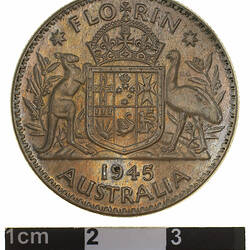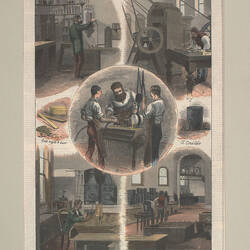Summary
Nickel Pattern Penny, minted by the Melbourne Mint in 1920. Raised Tail variety.
The production of bronze penny and halfpenny coins at the Melbourne Branch of the Royal Mint began in 1919. The first order from the Commonwealth began "pending the introduction of nickel coins..." leading mint authorities to believe that the introduction of nickel coins was imminent. Between 1919 and 1921 a number of experimental square patterns were produced.
Between 1919 and 1921 a series of experiments were undertaken for a square coinage in nickel to replace the large bronze penny and halfpenny coins. The shape and size was based of a coin from Ceylon (Sri Lanka). These patterns were never authorised for issue.
Physical Description
A square nickel pattern coin with rounded corners (18mm across, plain edge).
Obverse Description
Bare head of George V facing left; in a circle around, GEORGE V D.G. BRITT: OMN: REX 1920
Reverse Description
Kookaburra seated on small branch facing right its tail raised; curved above, AUSTRALIA; below at right in two lines, ONE PENNY
More Information
-
Collecting Areas
-
Acquisition Information
Transfer from National Gallery of Victoria (NGV), 15 Mar 1976
-
Date Issued
1920 AD
-
Issued By
-
Mint
-
Artist
-
Inscriptions
Obverse: GEORGE V D. G. BRITT: OMN: REX 1920 Reverse: AUSTRALIA ONE PENNY
-
Denomination
-
Series
-
Material
Nickel
-
Axis
12
-
Classification
-
Category
-
Discipline
-
Type of item
-
Dimensions
18 mm (Width), 18 mm (Depth), 3.881 g (Weight)
-
Shape
Square
-
References
McDonald 8
[Article] Sharples, John. 1985. Australian Coins 1919 to 1924. Journal of the Numismatic Association of Australia. 1 (July): 4-18.
-
Keywords
Australian Federation, 1901, Nickel Pattern Coins, Pattern Coins, Kookaburras









